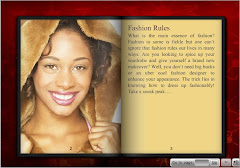Making Your Website Work for You:
Once you have identified the problem areas, it’s easier to narrow down to the solution. In web design, we need to primarily think about the visitor/user and why a person would even want to stay on your website.
A common thread to solve these problem areas is interactivity. Why interactivity? Well, let me do a quick check on this as well!
Let us see how we can resolve the problems discussed in the previous weeks with examples that reflect the solutions.
Overcoming High Bounce Rate with Interactivity

This website (above image) has successfully used a 3D flip book to present a company profile, its learning solutions, etc. The design is handled with great finesse as text is presented through an interactive flip book that helps to keep users on the page, which in turn reduces bounce rate! And yes, creating such 3D flip books is not as time consuming as you may think! Interactivity proves to bridge the gap between site visitors and website owners.
Increasing Attention Span of Visitors on Websites
 A curiously simple yet interactive website, M studio has things right in place! It first holds attention of the website visitor with this interesting range of colors and panels. As you go through the site, the different sections of the site are revealed in association with the varied colors seen in the image. It makes the visitor explore it further. The rest of the sections are unfolded only when some action is performed on the site from the visitor. The information is interestingly presented through the creative use of Flash!
A curiously simple yet interactive website, M studio has things right in place! It first holds attention of the website visitor with this interesting range of colors and panels. As you go through the site, the different sections of the site are revealed in association with the varied colors seen in the image. It makes the visitor explore it further. The rest of the sections are unfolded only when some action is performed on the site from the visitor. The information is interestingly presented through the creative use of Flash! Turning Visitors into Users
 As I mentioned in one of my earlier blogs, there is a need to convert visitors into users on websites. In the example above, the website includes an interesting mix of shopping products showcased through an interactive Panning Cards model. Here, the site owner would obviously want more and more visitors turning into a valued shopper for the site! The presentation of the products through Panning Cards is truly a boon for readers. They don’t have to scroll through long text description. Besides, the interactive model makes browsing easy and fun! The design appears inviting for a user to glance and begin exploring the site leading to an instant purchase after browsing through deals. Interactivity sure does play a major role out here!
As I mentioned in one of my earlier blogs, there is a need to convert visitors into users on websites. In the example above, the website includes an interesting mix of shopping products showcased through an interactive Panning Cards model. Here, the site owner would obviously want more and more visitors turning into a valued shopper for the site! The presentation of the products through Panning Cards is truly a boon for readers. They don’t have to scroll through long text description. Besides, the interactive model makes browsing easy and fun! The design appears inviting for a user to glance and begin exploring the site leading to an instant purchase after browsing through deals. Interactivity sure does play a major role out here! Well, all said and done, apart from interactivity, an attractive web layout and good navigational elements, you also need a dash of creativity and passion for excellence. With a combination of all these elements, I know your websites will surely work for you! Do post your most creative inspirations.















